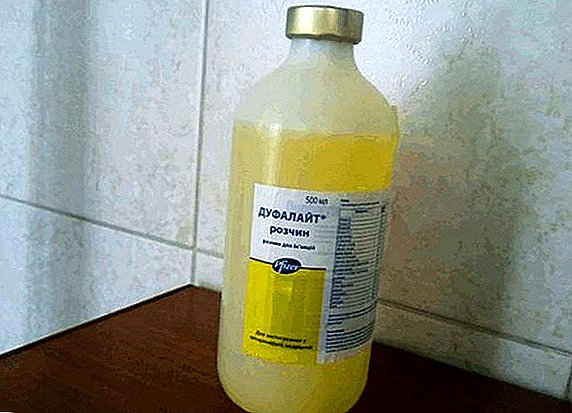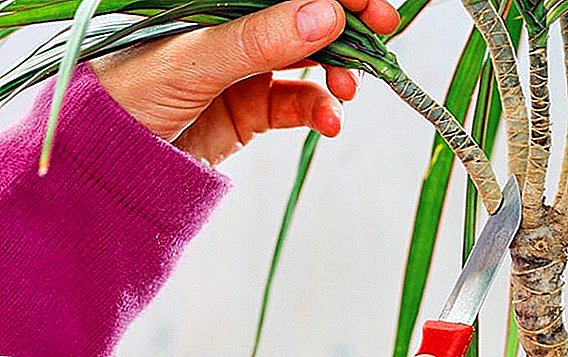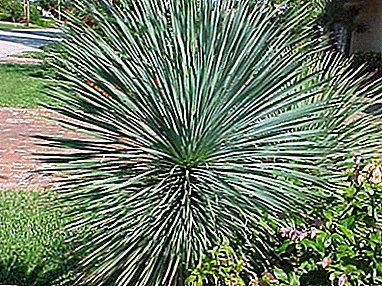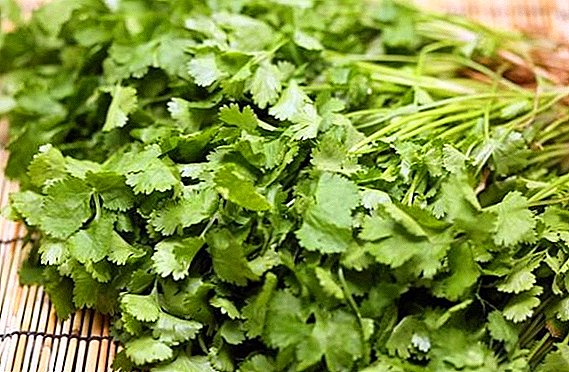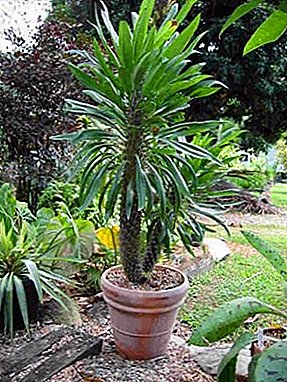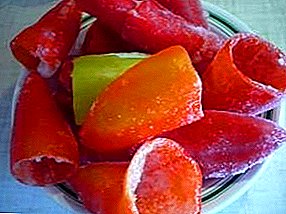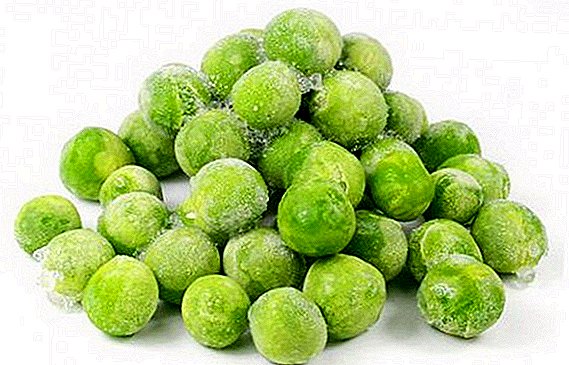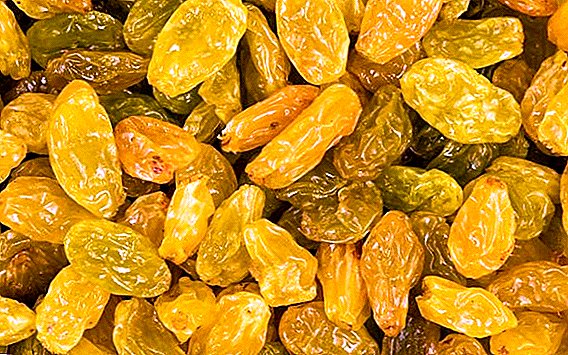 Grapes have long become an indispensable attribute of a well-groomed summer cottage or yard. In our latitudes, you can see the saplings of many varieties, but among them are the lines that give particularly delicate fruits. The popular white raisin belongs to them. Let's learn how to make delicious raisins out of its berries.
Grapes have long become an indispensable attribute of a well-groomed summer cottage or yard. In our latitudes, you can see the saplings of many varieties, but among them are the lines that give particularly delicate fruits. The popular white raisin belongs to them. Let's learn how to make delicious raisins out of its berries.
Briefly about grapes
White kishmish is a variety of dessert grapes with very small seeds or without them at all (therefore, there is no wild kishmish in nature). 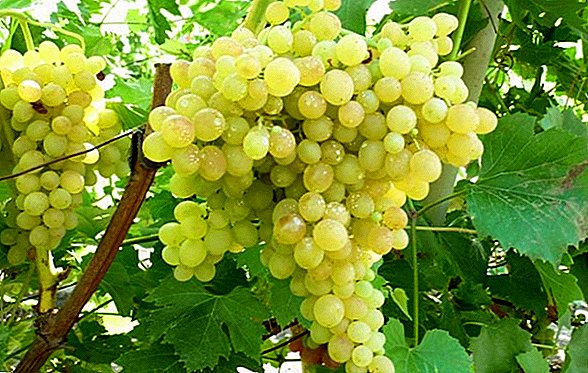 The vines are tall and strong, with smooth leaves, the edges of which are bent upwards. The vine ripens at an average pace, up to 70 buds usually appear on the hand. The clusters are mostly medium in size, but they also come across large, several branches.
The vines are tall and strong, with smooth leaves, the edges of which are bent upwards. The vine ripens at an average pace, up to 70 buds usually appear on the hand. The clusters are mostly medium in size, but they also come across large, several branches.
Check out the best grapes Kishmish grapes, especially such as Kishmish Zaporozhye, Kishmish radiant, Kishmish mirage.Small fruits have a slightly elongated oval or round shape. The color is yellow in various shades (from lemon to amber with dark dots). Translucent skin is quite easily torn.
The berries are sweet in taste, with a mildly sour aftertaste.
This line is considered to be moderately resistant, and with good care it is grown in temperate latitudes. Berries ripen on 155-175 days of vegetation. The yield is good, but there are some drawbacks. 
Important! It is recommended that people with diabetes mellitus or obesity refrain from consuming rash. Among the contraindications - too young age, as well as peptic ulcer.
So, white raisin is predisposed to the effects of diseases and pests, and the fragility of the berries complicates transportation. This was the reason that they are massively used for the procurement of dried fruits.
Nutrients and calorie raisin
The sweet taste of berries and the almost complete absence of grains made kishmish a favorite delicacy for many. Let's see what these berries "deliver" to our body.
Vitamins and Minerals
If you take the traditional portion of 100 g, then it turns out that the primacy among vitamins is for ascorbic acid (vitamin C). Her weight accounts for about 6 mg. 
The rest are present in such quantities:
- vitamin E - 4 mg;
- nicotinic acid (PP) - 0.3 mg;
- B vitamins with indices 1, 2, 5, 6 and 9 in a total amount of 0.22-0.25 mg;
- beta carotene - 0.03 mg;
- the proportion of vitamins A and H is calculated in micrograms (5 and 1.5, respectively).
More widely and weighty minerals are represented. The main macronutrient is potassium (225 mg for the same mass).
Other items much less:
- copper - 80 mg;
- calcium - 30 mg;
- sodium - 26 mg;
- phosphorus - 22 mg;
- magnesium - 17 mg;
- silicon - 12 mg;
- sulfur - 7 mg;
- chlorine - 1 mg.
 Their action is enhanced by a whole range of excipients. These are iron (0.6 mg) and zinc (0.091 mcg). The background components are aluminum and boron - 380 and 365 µg each.
Their action is enhanced by a whole range of excipients. These are iron (0.6 mg) and zinc (0.091 mcg). The background components are aluminum and boron - 380 and 365 µg each.Rubidium is 100 micrograms here, while chromium and molybdenum, vanadium and cobalt are just micrograms (from 2 to a maximum of 12).
Did you know? For the preparation of one bottle of wine (0.75 liters) an average of 600 grapes is required.
BJU and calorie
The indicator "proteins-fats-carbohydrates" in this case is expressed by the following figures:
- proteins - 0.72 g;
- fats - 0.17 g;
- carbohydrates - 17.2 g
 Calorie content - 69 kcal. True, this is a common figure for fresh berries, which may vary depending on the conditions in which the grapes grow.
Calorie content - 69 kcal. True, this is a common figure for fresh berries, which may vary depending on the conditions in which the grapes grow.What is the benefit of sultry
Due to this composition, kishmish exhibits many useful qualities, namely:
- supports immunity (due to ascorbic acid);
- cleans blood vessels, thereby preventing the occurrence of blood clots;
The vessels, such as corn, jalapeno pepper, pumpkin honey, red cabbage, and green sweet pepper, also clean the vessels.
- helps relieve symptoms of respiratory diseases;
- gently but effectively fights heartburn and nausea;
- regulates blood pressure;
- normalizes the digestive system (regular use prevents serious violations in the gastrointestinal tract - ulcers, colitis, etc.);
- acts as a strong choleretic agent, reduces the risk of diseases of the liver and kidneys;
- also acts as a diuretic component, relieves swelling;
- participates in the strengthening of bone tissue (which is valuable for the prevention of osteoporosis);
- acts as an anti-inflammatory product;
Rose hips, sage nutmeg, pine tar, grass lice, cloves, rogoz, and turmeric have anti-inflammatory properties.
- It has a beneficial effect on the work of the nervous system - it helps in the fight against stress, relieves stress and returns normal sleep.

Whether properties are lost when drying
We already know that the fruits of white raisin have a thin skin. For transportation it is a minus, but it is compensated by the obvious merits of the berries.
Important! Ordinary white raisins can tolerate wintering at -18-19 ° C. More related to frost is the related cultivar "Hungarian" (aka raisin 342), which easily tolerates temperatures of -21-26 ° C. Besides, he is not so suffering from various diseases.
The lack of seeds makes them an ideal raw material for obtaining raisins, and even the drying itself compares favorably with working with more “tough” varieties. The fact is that even after this procedure, the overwhelming majority of useful substances are preserved in the fruit: figures are given in 90-92%.
This indicator is the norm for sodish. Having taken a lot of fresh berries for 100%, we take out for brackets the fruits unsuitable for drying (about 6-7%) and waste (2-3%). It turns out that this dried fruit is almost as good as fresh harvest. 
Inventory and equipment for making raisins
Of course, the most delicious and useful will be the raisins, obtained with the observance of technology. It is easy even at home.
First you need to keep nearby the necessary kitchen utensils - a pot (preferably stainless steel), a large bowl for clean portions, a colander and a container for waste in the form of unusable fruits and brushes without berries.
The success of the procedure depends on the proper use of the electric dryer. It is this machine that turns fresh berries into raisins.
Such devices are both factory and homemade. In appearance, they are rectangular or cylindrical containers. The base plane (also known as the base) of a safe material has openings into which air enters.  The working part - lattice trays, which are set vertically. Their number can be different: from 5 to 20 (it all depends on the size of the product).
The working part - lattice trays, which are set vertically. Their number can be different: from 5 to 20 (it all depends on the size of the product).
In the factory samples, warm air is supplied separately to each tray, passing through a cavity in a double side wall. Temperature is regulated through the control panel, designed for 4-5 modes of operation.
Did you know? Only 2% of the world grape harvest is used for harvesting dried fruit. 27% of the fruit is eaten fresh, and the bulk is used for the production of wine.
Self-made designs are a bit simpler and allow you to work with a large amount of raw materials. But in any case, dense loading will somewhat slow down the process and require more electricity.  This recipe features a factory-made dryer.
This recipe features a factory-made dryer.
Ingredients Required
Here is their minimum:
- grape raisin - 5 kg;
- soda - 2.5 tsp.
How to choose grapes for the recipe
For the preparation of raisins used brushes with fruits of medium size - the largest berries are removed.
Naturally, the fruit must be ripe and free from damage. Tangible dryness and cracks, painful spots and thick dark "mesh" on the peel make the product unsuitable for further processing.
The best option - grapes grown on their own site with a minimum number of treatments with strong chemicals.  The purchaser loses a little to him: in mass cultivation, the clusters are sprayed with powerful pesticides, to which is also added the preservative E220 (sulfur dioxide used for better preservation).
The purchaser loses a little to him: in mass cultivation, the clusters are sprayed with powerful pesticides, to which is also added the preservative E220 (sulfur dioxide used for better preservation).
The drying process in the electric dryer with step by step photos
The grapes are harvested, all the necessary "props" at hand - you can proceed:
- The grapes washed in running water must first be blanched. In the pot with boiling water, add the right amount of soda (at the rate of ½ tsp. Per liter - here 5-liter container, respectively, takes 2.5 spoons).
- Clusters are placed in a colander, which is dipped in boiling water for 5-7 seconds. Because of the small size of this pot, several approaches will have to be made (the processed portions are immediately laid out in a voluminous bowl).
- Then the grapes are cooled in cold water to stop the cooking process, started by blanching.
- The cooled berries are separated from the grapes, removing to the side the most suspicious and damaged during the heat treatment process.
- After that, the whole fruits are laid out on trays (here there are 6). Pay attention - loading goes in one layer. If you put in 2, then the processing will take longer.
- The dryer is set at 55 ° C. In this mode, the grapes will dry for 34 hours.
- Opening the lid, it is easy to see that the berries have noticeably decreased in size. All raisin ready.

Important! The optimal interval between the filled trays in the dryer is 2-3 cm (while the minimum allowable gap is 5 mm).
Now a few numbers. Of the total 5 kg after the separation of the fruits from the ridges, 4196 g remained. Another 84 g was left in the waste (that is, 4112 g went to the tab). From this mass after drying it turned out 1.2 kg of raisins.
As you can see, there is nothing complicated: in the presence of equipment, you need only a bit of patience and accuracy at the initial stage. The result is worth it, but the fact that everything is made with your own hands always makes the delicacy a little tastier.
How else can you dry the grapes
The lack of electric dryers is not a cause for frustration. There are other tried and tested drying methods. The most popular are exposure to the sun and in the oven.
In the sun
The simplest method, tested for centuries. In addition to grapes, a drying platform is required.  Ideally, this is a large frame with a thick mesh stretched over wooden planks. But other available materials will also fit - you can put berries on cardboard, plywood or burlap.
Ideally, this is a large frame with a thick mesh stretched over wooden planks. But other available materials will also fit - you can put berries on cardboard, plywood or burlap.
The main thing - to put the grapes in a single layer. In warm weather, the process will take a couple of weeks. On a fine, but windy day, stocks should be covered with thick gauze, which will not allow them to scatter.
Did you know? In terms of nutrients (with the exception of fats), grapes are very close to milk.
Do not forget to inspect the drying, as necessary, bringing it into the room (for example, in rainy weather or at the time of departure from the site).
Determine the degree of readiness - a couple of trivialities: fruits that have reached the state of raisins stand out in a dark amber color with overflows and soft to the touch, even slightly viscous (with natural drying 15-20% of moisture is preserved). 
In the oven
A faster option - extract in the oven:
- Grapes spread on two baking sheets, covered with thick paper.
- Making sure that the berries are laid in a single layer, the containers with them are put into an oven heated to 55-60 ° С, slightly opening the door (to get out moisture).
- Fruits need to be stirred periodically, at the same time changing the pans in places.
- Ready raisins in color will be the same as with street drying.
The time of such cooking can be quite different - it all depends on how the oven works (it happens that it barely "pulls" and you have to take breaks in the process).
How to grow grapes for drying yourself
Many in the areas planted raisins, which pleases with its fruits (and those in the future can turn into raisins). Therefore, we will find out in the most general terms what the agricultural machinery looks like in the case of white raisins. 
Choosing a place
This grape needs space: seedlings are placed approximately 1 m from the fence, with an interval of 2-3 m between them.
Important! For all grape varieties, the light mode is important: the plant does not like a thick shadow.
The presence of support is mandatory, and as you grow, you will need stretch marks (for several bushes, a full-fledged arch of twigs will be required).
Landing
The optimal time frame is from the end of April to the third decade of May. At this point, the soil begins to warm up, and the threat of sudden cold weather erodes.  Under the seedling dig a hole with a depth of 70 cm (with a diameter of 75-80). A drainage in the form of gravel is placed on the bottom, and a mixture of sand, sod and humus is put on it in equal parts. Then the support is put and the seedling is carefully placed, the roots of which are covered with clean soil.
Under the seedling dig a hole with a depth of 70 cm (with a diameter of 75-80). A drainage in the form of gravel is placed on the bottom, and a mixture of sand, sod and humus is put on it in equal parts. Then the support is put and the seedling is carefully placed, the roots of which are covered with clean soil.
Learn how to plant your own grapes in spring and autumn, and how to plant grapes in the fall by cuttings.
It remains to pour a bush (10 liters of water) and grind it.
In the same sequence, you can land the raisins in the fall, from the beginning of October until the first frost. But in this case, more trouble - you will have to cover the sapling with a plastic bottle with holes cut through the ventilation, and on the eve of cold weather you should also cover it with needles or a thick layer of sawdust.
Care
It all starts with the very first trim on 2 peepholes, which is done in the first year. Further, seasonal trimming (8–12 eyes) and removal of weak branches are carried out. 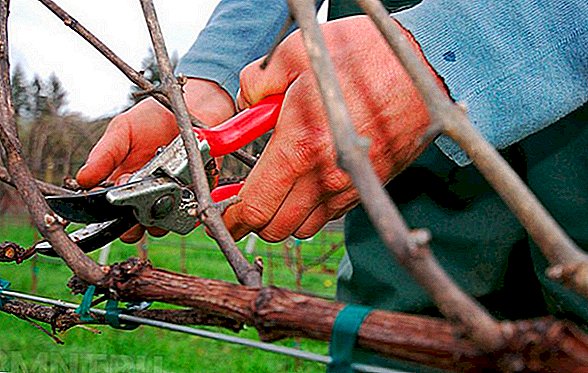 Watering in warm weather is reduced to 15 liters of water under each bush with an interval of 3-4 days. A couple of weeks before harvesting, watering is limited, slightly wetting the ground between the bushes.
Watering in warm weather is reduced to 15 liters of water under each bush with an interval of 3-4 days. A couple of weeks before harvesting, watering is limited, slightly wetting the ground between the bushes.
Did you know? In ancient Russian mythology, the forbidden paradise tree was considered not an apple tree, but a vine bush.
The top dressing scheme is also simple: nitrogen compounds are added in the spring, and magnesium sulphate mixed with calcium phosphate is used for supplements. Home "recharge" held on the eve of flowering.
To control pests use different insecticides, which differ in the dose and method of treatment (see instructions).
Such products as "BI-58", "Fastak", "Kinmiks", "Angio", "Calypso", "Omayt", "Marshal" are considered as insecticides.
Harvesting
It falls on the end of July - the beginning of August. More specific terms depend on the variety, weather conditions in the region and competent care.  Clusters weighty: on average from 250 to 400 g, on good soils can grow and brush in 500-600 g
Clusters weighty: on average from 250 to 400 g, on good soils can grow and brush in 500-600 g
Now you know how to get raisins from white raisins, what is the use of these fruits and what does the cultivation of these grapes look like in general. We hope this information is useful, and our readers will be able to please themselves with dried fruits of their own preparation. Enjoy your meal!


